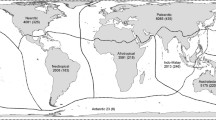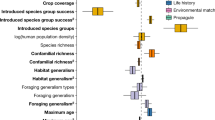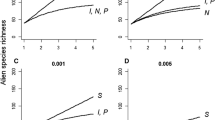Abstract
The most significant single event in the study of alien bird invasions occurred in 1981, with the publication of John L. Long’s seminal book “ Introduced birds of the world” (full title: Introduced birds of the world: The worldwide history, distribution and influence of birds introduced to new environments”; David & Charles Ltd., Newton Abbot, UK). The significance of this book derives not just from its content, but also from its timing, coincident with the 1982 Scientific Committee on Problems of the Environment (SCOPE) programme on the ecology of biological invasions. It was not long before studies started to appear that exploited the data in Long’s book to address the questions posed by SCOPE regarding alien invasions. As a result, we arguably have a more complete understanding of the invasion process for birds than for any other taxon. Nevertheless, there are still some key issues in the study of bird invasions where understanding is not all it should be. The aim of this review is to highlight four of these issues by arguing that (1) we do not know half so much about bird invasions as we think; (2) propagule pressure promotes invasions; (3) colonization pressure matters; (4) there is no evidence that escape from parasites promotes alien (bird) invasions. We expect some of the views expressed to be controversial, and others less so, but either way we hope this paper will stimulate others to provide better evidence for—or against—our propositions.
Zusammenfassung
Der wichtigste Moment in der Erforschung der Vogelinvasionen war das Erscheinen John L. Long’s Buches „Eingeführte Vögel der Welt“ 1981 [Titel in Englisch: Introduced birds of the world: The worldwide history, distribution and influence of birds introduced to new environments”; David & Charles Ltd., Newton Abbot, UK]. Die Bedeutsamkeit dieses Buches ist nicht nur dem Inhalt geschuldet, sondern auch dem Zeitpunkt. 1982 begann der wissenschaftliche Beirat der Umweltprobleme [Englisch: Scientific Committee on Problems of the Environment (SCOPE)] mit seinem Programm über die Ökologie biologischer Invasionen. Kurz danach erschienen die ersten Studien, die Long‘s Daten nutzten um einige der Fragen zu biologischen Invasionen aus dem SCOPE Programm zu beantworten. Auch resultierend daraus haben wir heute unbestreitbar ein weitaus tieferes Verständnis der Invasionsprozesse von Vögeln als für irgendeine andere Artengruppe. Trotz allem gibt es immer noch Lücken im Verständnis von Vogelinvasionen. Das Ziel dieser Übersichtsarbeit ist es vier dieser Lücken zu adressieren, indem wir argumentieren, dass (1) nur halb so viel über Vogelinvasionen wissen, als wir denken; (2) Propagulendruck Invasionen unterstützt; (3) Kolonisierungsdruck eine Rolle spielt; (4) es keine Beweise gibt, dass die Abwesenheit von Parasiten(Vogel-)Invasionen unterstützt. Wir hoffen, dass unsere mehr oder weniger kontroversen Ansichten andere Forscher anregen weitere Beweise für oder gegen unsere Behauptungen zu liefern.



Similar content being viewed by others
References
Allendorf FW, Luikart GH, Aitken SN (2012) Conservation and the genetics of populations. Wiley, New York
Blackburn TM, Duncan RP (2001) Establishment patterns of exotic birds are constrained by non-random patterns in introduction. J Biogeogr 28:927–939
Blackburn TM, Lockwood JL, Cassey P (2009a) Avian invasions. The ecology and evolution of exotic birds. Oxford University Press, Oxford
Blackburn TM, Lockwood JL, Cassey P (2009b) Following birds along the pathway to invasion. The Biologist 56:80–85
Blackburn TM, Prowse TAA, Lockwood JL, Cassey P (2011a) Passerine introductions to New Zealand support a positive effect of propagule pressure on establishment success. Biodivers Conserv 20:2189–2199
Blackburn TM, Pyšek P, Bacher S, Carlton JT, Duncan RP, Jarošík V, Wilson JRU, Richardson DM (2011b) A proposed unified framework for biological invasions. Trends Ecol Evol 26:333–339
Blackburn TM, Prowse TAA, Lockwood JL, Cassey P (2013) Propagule pressure as a driver of establishment success in deliberately introduced exotic species: fact or artefact? Biol Invasions 15:1459–1469
Brett MT (2004) When is correlation between non-independent variables “spurious”? Oikos 105:647–656
Brown JH (1989) Patterns, modes and extents of invasions by vertebrates. In: Drake JA, di Castri F, Groves RH, Kruger FJ, Rejmánek M, Williamson M (eds) Biological invasions, a global perspective. Wiley, Chichester, pp 85–109
Callaway RM, Thelen GC, Rodriguez A, Holben WE (2004) Soil biota and exotic plant invasion. Nature 427:731–733
Cassey P (2002) Life history and ecology influences establishment success of introduced land birds. Biol J Linn Soc 76:465–480
Cassey P, Blackburn TM, Sol D, Duncan RP, Lockwood JL (2004) Introduction effort and establishment success in birds. Proc R Soc Lond B [Suppl] 271:S405–S408
Cassey P, Blackburn TM, Duncan RP, Lockwood JL (2005) Lessons from the establishment of exotic species: a meta-analytical case study using birds. J Anim Ecol 74:250–258
Caswell H (2001) Matrix population models. Sinauer Assoc, Sunderland
Cohen AN, Carlton JT (1998) Accelerating invasion rate in a highly invaded estuary. Science 279:555–558
Colautti RI, Ricciardi A, Grigorovich IA, MacIsaac HJ (2004) Is invasion success explained by the enemy release hypothesis? Ecol Lett 7:721–733
Colautti RI, Grigorovich IA, MacIsaac HJ (2006) Propagule pressure: a null model for biological invasions. Biol Invasions 8:1023–1037
Cooney R, Jepson P (2006) The international wild bird trade: what’s wrong with blanket bans? Oryx 40:18–23
Crosby AW (1993) Ecological imperialism: the biological expansion of Europe, 900–1900. Cambridge University Press, Cambridge
Dawson JC (1984) A statistical analysis of species characteristics affecting the success of bird introductions. BSc Thesis, University of York, York
Drake JA, di Castri F, Groves RH, Kruger FJ, Rejmánek M, Williamson M (eds) (1989) Biological invasions, a global perspective. Wiley, Chichester
Duncan RP, Blackburn TM, Sol D (2003) The ecology of bird introductions. Annu Rev Ecol Evol Syst 34:71–98
Duncan RP, Blackburn TM, Rossinelli S, Bacher S (2014) Quantifying invasion risk: the relationship between establishment probability and founding population size. Methods Ecol Evol 5:1255–1263
Elton C (1958) The ecology of invasions by animals and plants. Methuen, London
Environment and Animal Society of Taiwan (EAST) (2009) The investigation of prayer animal releases in Taiwan. Environment and Animal Society of Taiwan, Taiwan. Available at http://www.east.org.tw/that_content.php?s_id=14&m_id=0&id=89
Food and Agricultural Organization (FAO) (2011) International trade in wild birds, and related bird movements, in Latin America and the Caribbean. Animal Production and Health Paper No. 166, FAO, Rome
Fox GA (2005) Extinction risk of heterogeneous populations. Ecology 86:1191–1198
Genovesi P, Bacher S, Kobelt M, Pascal M, Scalera R (2009) Alien mammals of Europe. In: DAISIE (ed) Handbook of alien species in Europe. Springer, Dordrecht, pp 119–128
Hayes KR, Barry SC (2008) Are there any consistent predictors of invasion success? Biol Invasions 10:483–506
Inderjit, van der Putten WH (2010) Impacts of soil microbial communities on exotic plant invasions. Trends Ecol Evol 25:512–519
International Union for the Conservation of Nature (IUCN) (2014) IUCN Red list of threatened species. Available at http://www.iucnredlist.org
Jepson P, Ladle RJ (2005) Bird-keeping in Indonesia: conservation impacts and the potential for substitution-based conservation responses. Oryx 39:1–6
Jerde CL, Lewis MA (2007) Waiting for invasions: a framework for the arrival of nonindigenous species. Am Nat 170:1–9
Kark S, Solarz W, Chiron F, Clergeau P, Shirley S (2009) Alien birds, amphibians and reptiles of Europe. In: DAISIE (ed) Handbook of alien species in Europe. Springer, Dordrecht, pp 105–118
Keane RM, Crawley MJ (2002) Exotic plant invasions and the enemy release hypothesis. Trends Ecol Evol 17:164–170
Klironomos JN (2002) Feedback with soil biota contributes to plant rarity and invasiveness in communities. Nature 417:67–70
Leader-Williams N, Tibanyenda RK (eds) (1996) The live bird trade in Tanzania. International Union for the Conservation of Nature, Gland
Leung B, Drake JM, Lodge DM (2004) Predicting invasions: propagule pressure and the gravity of Allee effects. Ecology 85:1651–1660
Lever C (2005) Naturalised birds of the world. T & AD Poyser, London
Li L, Jiang Z (2014) International trade of CITES listed bird species in China. PLoS ONE 9:1–8
Li S-H, Yeung CK-L, Han L, Le MH, Wang C et al (2010) Genetic introgression between an introduced babbler, the Chinese hwamei Leucodioptron c. canorum, and the endemic Taiwan hwamei L. taewanus: a multiple marker systems analysis. J Avian Biol 41:64–73
Lockwood JL (1999) Using taxonomy to predict success among introduced avifauna: relative importance of transport and establishment. Conserv Biol 13:560–567
Lockwood JL, Cassey P, Blackburn T (2005) The role of propagule pressure in explaining species invasions. Trends Ecol Evol 20:223–228
Lockwood JL, Cassey P, Blackburn TM (2009) The more you introduce the more you get: the role of colonization pressure and propagule pressure in invasion ecology. Divers Distrib 15:904–910
Long JL (1981) Introduced birds of the world. The worldwide history, distribution and influence of birds introduced to new environments. David & Charles, London
Lonsdale WM (1999) Global patterns of plant invasions and the concept of invisibility. Ecology 80:1522–1536
Mawson J (2003) Prologue to the introduction. In: Long JL (ed) Introduced mammals of the world. CSIRO Publishing, Collingwood
McDowall RM (1994) On size and growth in freshwater fish. Ecol Freshw Fish 3:67–79
Mitchell CE, Power AG (2003) Release of invasive plants from fungal and viral pathogens. Nature 421:625–627
Mitchell CE, Agrawal AA, Bever JD, Gilbert GS, Hufbauer RA, Klironomos JN, Maron JL, Morris WF, Parker IM, Power AG et al (2006) Biotic interactions and plant invasions. Ecol Lett 9:726–740
Moulton MP (1993) The all-or-none pattern in introduced Hawaiian passeriforms: the role of competition sustained. Am Nat 141:105–119
Moulton MP, Cropper WP Jr (2014) Establishment success in introduced passeriforms of New Zealand: evidence for a Franklin Delano Roosevelt effect. Biol Invasions 16:233–237
Moulton MP, Pimm SL (1983) The introduced Hawaiian avifauna: biogeographic evidence for competition. Am Nat 121:669–690
Moulton MP, Cropper WP Jr, Avery ML, Moulton LE (2010) The earliest house sparrow introductions to North America. Biol Invasions 12:2955–2958
Moulton MP, Cropper WP Jr, Avery ML (2011) A reassessment of the role of propagule pressure in influencing fates of passerine introductions to New Zealand. Biodivers Conserv 20:607–623
Moulton M, Cropper WP Jr, Moulton LE, Avery ML, Peacock D (2012a) A reassessment of historical records of avian introductions to Australia: no case for propagule pressure. Biodivers Conserv 21:155–174
Moulton MP, Cropper WP Jr, Avery ML (2012b) Historical records of passerine introductions to New Zealand fail to support the propagule pressure hypothesis. Biodivers Conserv 21:297–307
Moulton MP, Cropper WP Jr, Avery ML (2013) Is propagule size the critical factor in predicting introduction outcomes in passeriform birds? Biol Invasions 15:1449–1458
Pipek P, Pyšek P, Blackburn TM (2014) How the Yellowhammer became a Kiwi: the history of an alien invasion revealed. NeoBiota 24:1–31
Regueira RFS, Bernard E (2012) Wildlife sinks: quantifying the impact of illegal bird trade in street markets in Brazil. Biol Conserv 149:16–22
Richardson DM, Pyšek P, Rejmanek M, Barbour MG, Panetta FD, West CJ (2000) Naturalization and invasion of alien plants: concepts and definitions. Divers Distrib 6:93–107
Roques A, Rabitsch W, Rasplus J-Y, Lopez-Vaamonde C, Nentwig W, Kenis M (2009) Alien terrestrial invertebrates of Europe. In: DAISIE (ed) Handbook of alien species in Europe. Springer, Dordrecht, pp 63–80
Roy HE, Peyton J, Aldridge DC, Bantock T, Blackburn TM, Bishop J, Britton R, Clark P, Cook E, Dehnen-Schmutz K, Dines T, Dobson M, Edwards F, Harrower C, Harvey MC, Minchin D, Noble DG, Parrott D, Pocock MJO, Preston CD, Roy S, Salisbury A, Schönrogge K, Sewell J, Shaw RH, Stebbing P, Stewart AJA, Walker KJ (2014) Horizon-scanning for invasive alien species with the potential to threaten biodiversity in Great Britain. Glob Change Biol 20:3859–3871
Severinghaus LL (2007) The breeding ecology and dispersal of Taiwan and light-vented bulbuls in Kenting National Park. J Natl Park 17:27–41
Shea K, Chesson P (2002) Community ecology as a framework for biological invasions. Trends Ecol Evol 17:170–176
Shieh B-S, Lin Y-H, Lee T-W, Chang C-C, Cheng K-T (2006) Pet trade as sources of introduced bird species in Taiwan. Taiwania 51:81–86
Simberloff D (2009) The role of propagule pressure in biological invasions. Annu Rev Ecol Evol Syst 40:81–102
Simberloff D (2011) Charles Elton: neither founder nor siren, but prophet. In: Richardson DM (ed) Fifty years of invasion ecology. The legacy of Charles Elton. Wiley, Oxford, pp 11–24
Sol D (2000) Are islands more susceptible to be invaded than continents? Birds say no. Ecography 23:687–692
Sol D, Duncan RP, Blackburn TM, Cassey P, Lefebvre L (2005) Big brains, enhanced cognition, and response of birds to novel environments. Proc Natl Acad Sci USA 102:5460–5465
Sol D, Maspons J, Vall-llosera M, Bartomeus I, García-Peña GE, Piñol J, Freckleton RP (2012) Unraveling the life history of successful invaders. Science 337:580–583
Su S, Cassey P, Blackburn TM (2014) Patterns of non-randomness in the composition and characteristics of the Taiwanese bird trade. Biol Invasions 16. doi:10.1007/s10530-014-0686-1
Thomson GM (1922) The naturalisation of plants and animals in New Zealand. Cambridge University Press, Cambridge
Torchin ME, Lafferty KD, Dobson AP, McKenzie VJ, Kuris AM (2003) Introduced species and their missing parasites. Nature 421:628–630
van Kleunen M, Fischer M (2009) Release from foliar and floral fungal pathogen species does not explain the geographic spread of naturalized North American plants in Europe. J Ecol 97:385–392
van Kleunen M, Dawson W, Schlaepfer D, Jeschke JM, Fischer M (2010) Are invaders different? A conceptual framework of comparative approaches for assessing determinants of invasiveness. Ecol Lett 13:947–958
Westphal MI, Browne M, MacKinnon K, Noble I (2008) The link between international trade and the global distribution of invasive alien species. Biol Invasions 10:391–398
Williamson M (1996) Biological invasions. Chapman and Hall, London
Williamson MH, Kornberg H, Holdgate MW, Gray AJ, Conway GR (1986) Preface: the British contribution to the SCOPE program on the ecology of biological invasions. Philos Trans R Soc Lond B 314:1–2
Yao C-T (2007) The elimination and caged raise of exotic Red-billed blue magpie Urocissa erythrorhyncha in Wu-ling National Forest Recreation Area. Endemic Species Research Institute, Council of Agriculture, Executive Yuan, Taiwan/Wu-ling National Forest Recreation Area, Taiwan
Acknowledgements
We thank the organizing committee of the 26th International Ornithological Congress for the opportunity to present our work, and two anonymous referees for their helpful comments on an earlier version of the paper. This study was supported by the King Saud University Distinguished Scientist Fellowship Program (TMB), and by an ARC Discovery Grant (DP140102319) and Future Fellowship (FT0991420) to PC.
Author information
Authors and Affiliations
Corresponding author
Additional information
Communicated by E. Matthysen.
Rights and permissions
About this article
Cite this article
Blackburn, T.M., Dyer, E., Su, S. et al. Long after the event, or four things we (should) know about bird invasions. J Ornithol 156 (Suppl 1), 15–25 (2015). https://doi.org/10.1007/s10336-015-1155-z
Received:
Revised:
Accepted:
Published:
Issue Date:
DOI: https://doi.org/10.1007/s10336-015-1155-z




